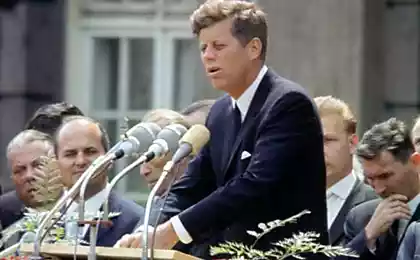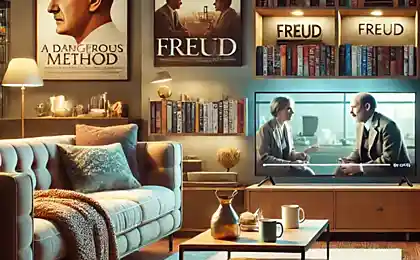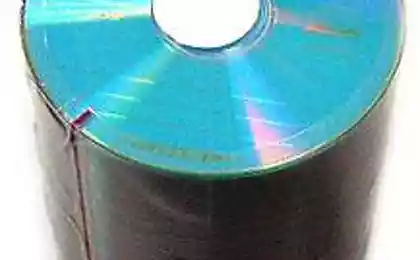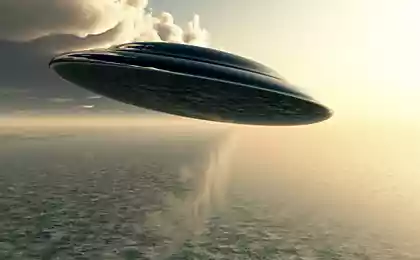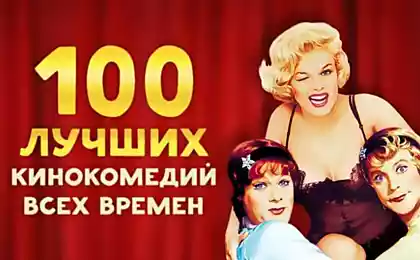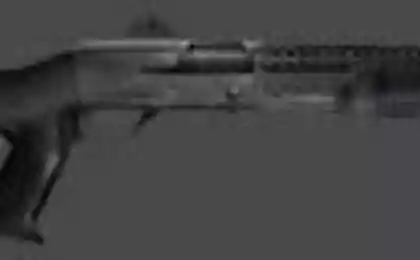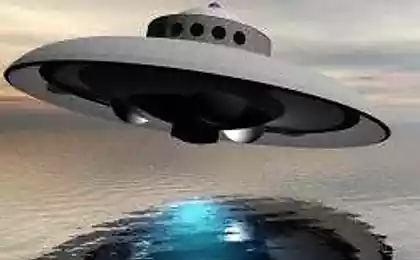1000
UFO. The secret project of the US Army
Canadian firm "Avro Erkraft" from 1955 initiated a study of jet taking off vertically with a circular disc-shaped apparatus housing and a device for the formation of an air cushion during takeoff. It was assumed that such a scheme VTOL, with driven lift fan of the turbojet engine, proposed in 1947 by the English designer John Frost, through the use of air cushion take-off requires less installed power than conventional jet VTOL aircraft.

Also cast by the fan air flow mixed with the gas turbojet and used to form an air cushion will have a much lower speed and temperature than the turbojet engine, which should simplify the operation of the VTOL. Therefore, the development of VTOL firm "Avro Erkraft" interested in the Air Force and the US Army, who participated in the research funding should be noted that the scheme VTOL with a disk-shaped carrier body and located therein fan was offered ac. BN Yuriev even in 1921, the scheme, see "Russia. Research screw VTOL ».

In 1959, the contract for the combined Army and US Air Force has completed the construction of an experimental VTOL with a disk-shaped body which has received official designation VZ-9V, and the name "avrocar" and better known under the name "Flying Soser" (flying saucer). The first tests on a leash VTOL VZ-9V began to take place December 5, 1959, making a short flight, and soon was transferred to the Air Force base test them. Edwards. First off with the transition to horizontal flight took place May 17, 1961

Frost decided to use the already usual for that time reactive thrust in combination with the so-called Coanda effect. The essence of this phenomenon lies in the fact that the jet of liquid or gas, moving close to any object tends to get closer to her, or even the "stick." As planned Frost, this behavior was to facilitate the air handling unit. First, engineers Avro Canada made a small unit to demonstrate their ideas. The model with a diameter of 11 centimeters could rise into the air at low altitude, but there are no mechanisms for maneuvering it did not fit. Nevertheless, the Canadian Defense Ministry interested in the idea and has allocated about 400 thousand US dollars to continue the work. Shortly thereafter, the project has received index Y2.

At this stage, the future Avrocar became the object of espionage drama. Since 1952, the CIA was trying to find out whether some of the new aircraft designs. In the 53 th Scouts learned about the existence of the project Y2 and reported it to his superiors. Shortly after the transfer of documents "up" the gentlemen of the Pentagon contacted the Canadian military and asked them to continue creating Y2 together. Canada has adopted the proposal. Among other things, it was nice, and the financial implications. Head of research department USAF Lieutenant General J. Patt knocked the funding of two million dollars a year. Very boldly for a revolutionary new project. However, the money was allocated and Avro continued research. By mid-decade, the project was ready VZ-9, which is, strictly speaking, was the "swan song" of the program Y2.
Development VTOL VZ-9V led by John Frost and his tests were conducted in the greatest secrecy, so it was published on the very limited information. Perhaps the extraordinary form of VTOL and the lack of official data on the tests conducted in 1961 - 1962 years., Called this period of intense publication about flying unidentified flying objects (UFO) in the form of "flying saucers».
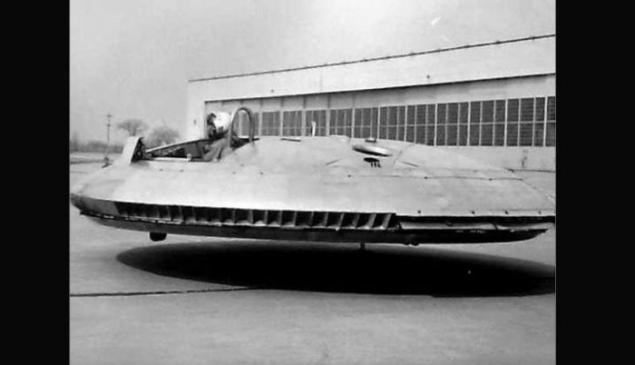
Of fifteen disk with six turbojet engines, which emit gases through its own nozzle and drives the rotation of the turbine large size could theoretically climb to any height and fly in any direction. The customer in the face of US and Canadian military approved the project, but asked at first to try the new technology at a manned machine smaller. Because of this "plate" uzhali to a diameter of about six meters. Appropriately modified and powerplant: Now around the center of the turbine was located only three engines. Interesting flight control system. To raise or lower draft was supposed to change all engines at once, which affects the momentum of the turbine lift. To tilt in one direction or another Avrocar had a special system that changed the thrust of individual engines so that housing unit due to its differences leaning in the right direction. With this system had pretty tricky: it was necessary to take into account the engine response, stability of the whole system and a host of other parameters.
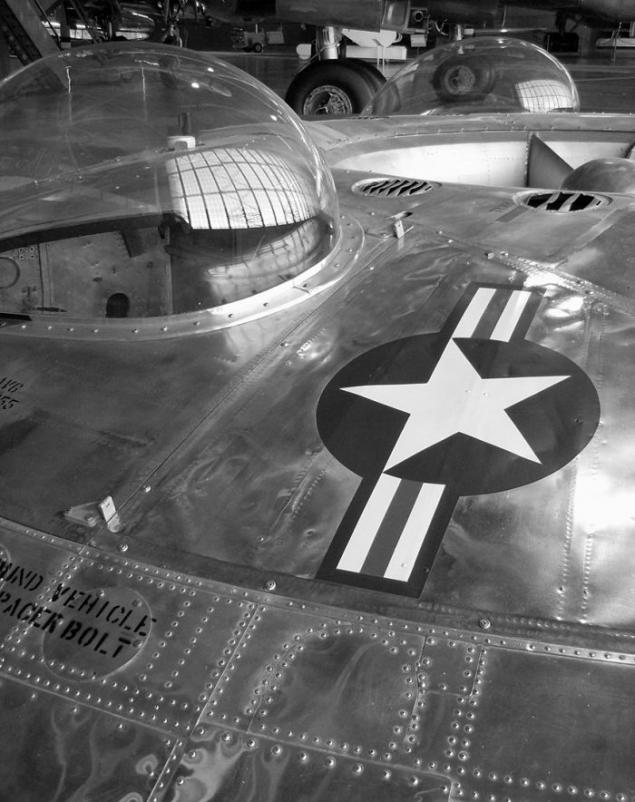
In mid-1959 the first prototype "avrocar" was ready. It is time for the test. The first week went to the training of interaction engines and control systems. It was not easy, but Canadians and Americans to deal with it. By November of that year, VZ-9 unit was ready for the first flight. November 12 "flying saucer" off the ground and hovered at low altitude. Over time, we began to gain traction and output device for a little more height. At a distance of about one meter from the ground Avrocar hanging loosely, maneuvered and can move in any direction. But when it came to rise to a height of at least several meters, suddenly it became clear one very unpleasant feature of the project. Relatively weak power plant prototype could provide a satisfactory stability and control only to a height of one and a half meters. With a further rise "avrocar" had to rely solely on the Coanda effect. Screen effects, in turn, was lost and the aircraft lost its former stability. After a series of test flights engineers "Avro Canada" had to go back for Cullman. Meanwhile, the results of disgruntled Canadian military came to the conclusion about the futility of the project and refused to continue to give out money.
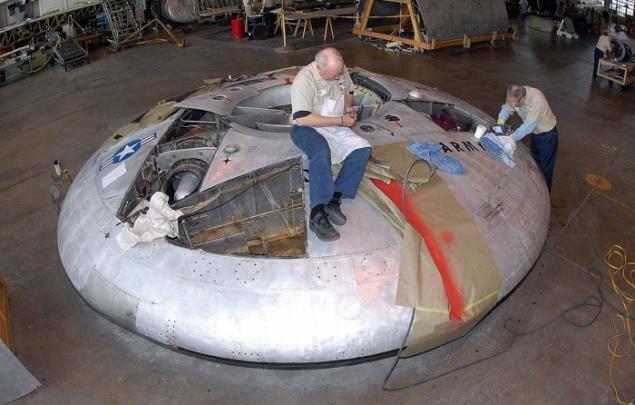
Over the next months, a team of designers under the George. Frost was trying to find a solution for the detected problems and provide adequate stability. At this stage of the work it has been collected a few models, which worked out new ideas. However, none of the models are not able to rise to a decent height and it does not turn over. Among the reasons for this behavior sets the number and the absence of additional air support (the same ground effect), and demanding designs to accurately and precisely balanced and the need to synchronize the engines.
Correct all this was possible only by means of a fundamental change in the structure. In late 1960, Frost began refining the project in accordance with the collected experiences. Starting from 1959, the year the project financing Y2 carried out only by the United States. Responsible for maintaining the program, US officials eventually became too doubt its feasibility. Therefore, soon after the start of a radical modernization of the funding "avrocar" stopped. Staff at the Pentagon have been tough and terse. The document on the termination of studies indicates the futility of the project, as well as the absence of any satisfactory result at a cost of about twelve million dollars.
In 1962, the development of VTOL VZ-9V was discontinued.

Recent tests carried out VTOL VZ-9V «avrocar" showed that it is not sufficiently resistant, in addition, constantly experience problems in its propulsion system and control system caused the termination of its test, despite the touted prospects for its use.

The principal difference between the experimental VTOL VZ-9V «avrocar" was that he could not only fly like an airplane at high altitude, but also to move close to the ground on an air cushion. The unit had a round disc-shaped body, the center of which was a fan. They sucked air through the system of channels directed to the single-loop ring nozzle that passes along the periphery of the device.

The lifting force when hovering or moving VTOL VZ-9V near the ground to create, first, thanks to the air cushion formed during the outflow of air from the annular nozzle, and secondly, as a result of so-called Coanda effect, which is usually manifested in the outflow of air from profiled nozzle above the surface to: create a vacuum gives rise to a lifting force. The VTOL VZ-9V when the flow of air through the ejection nozzle due to suction of air performed from the upper surface of the housing unit, causing underpressure therein and create additional lift.
The air ejected through the annular gap on the upper surface of the housing unit. Central fan diameter of 1, 52 m was driven by the low-speed turbine, driven in rotation by the flow of gas emanating from a nozzle three turbojet Continental J69-T9 with a thrust of 420 kg, or an equivalent power of 1,000 bhp To create a horizontal thrust ring air curtain can be deflected by a rotary control surfaces in an annular nozzle.
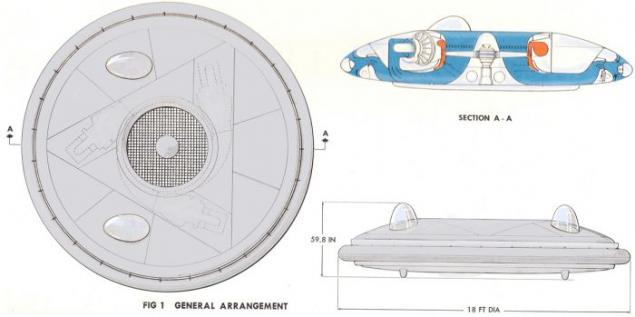
VTOL transition from movement on an air cushion above the ground to the coast as follows: VTOL accelerated above the ground on an air cushion to such a speed that its disc-shaped body creating a lifting force sufficient to maintain in the air, and then for his recovery. This annular jet, rolling, turning into flat veil and flowing out of the annular air nozzle creating horizontal thrust.
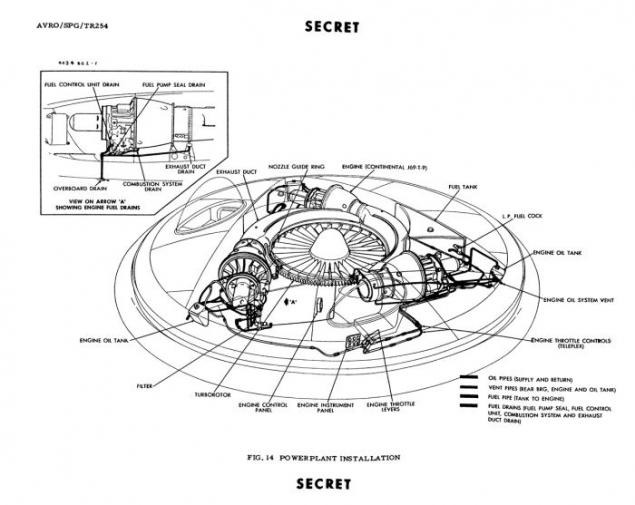
Built experimental VTOL VZ-9V «avrocar" designed to fly at subsonic speeds, so it had a rounded toe ring round the wing and the air intake on the perimeter of the wing to enter the ejected air flow. Round disc-shaped body with a diameter of 5 5 m was elliptical profile with a relative thickness of 20% and 2% of curvature. Features VTOL VZ-9V not been published, but indicated that he may have a maximum speed of 480 km / h.
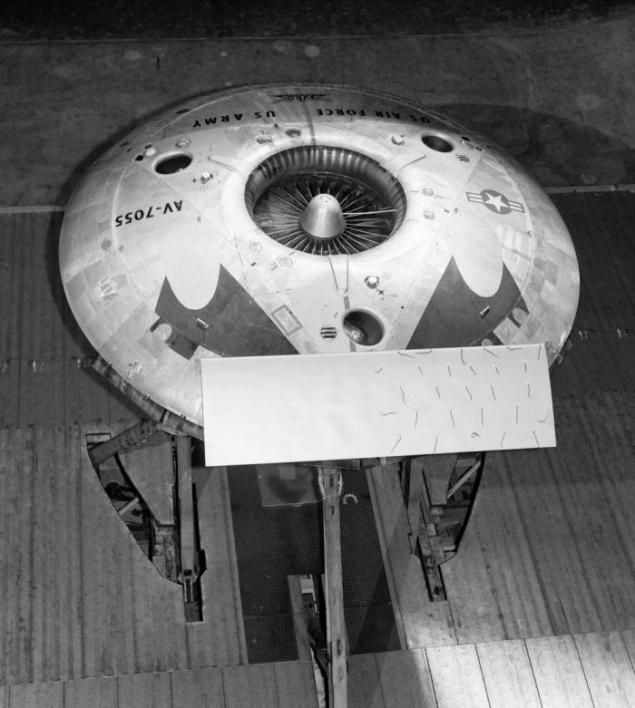
Firm "Avro Erkarft" was designed as a supersonic VTOL variant of this type, whose wing was to have a sharp edge and a modified intake system ejected air. Such an apparatus different structural compactness and may have a relatively small mass; it is configured with a circular wing advertised as optimal for flying at low altitudes at high speeds, on the condition that will be solved the problem of stability.

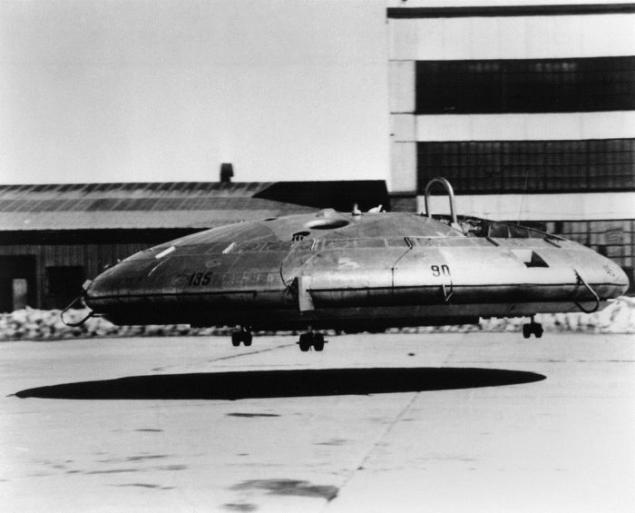
To have survived both the built prototype Avrocar, which are stored in aviation museums in the US. Ten years ago, a number of Canadian historians made for the transfer of one of the "avrocar" in the hands of Canada. They explained this by the need of recognition of the country in the creation of the project. This theme fund shares somehow get round, although the US has spent on the program Y2 in more than ten times more money than their northern neighbor. In particular, and therefore the beginning of the two thousandth talk remained talk, and both built VZ-9 still are in American museums.
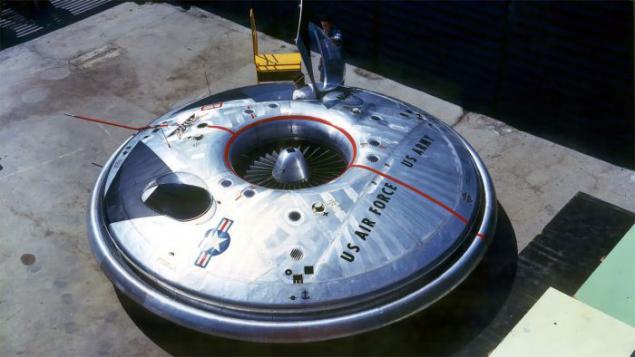
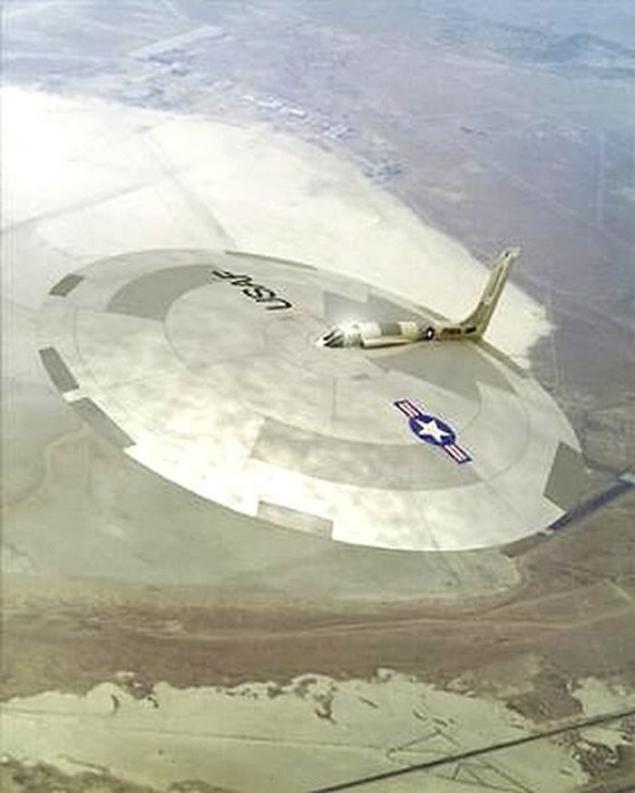
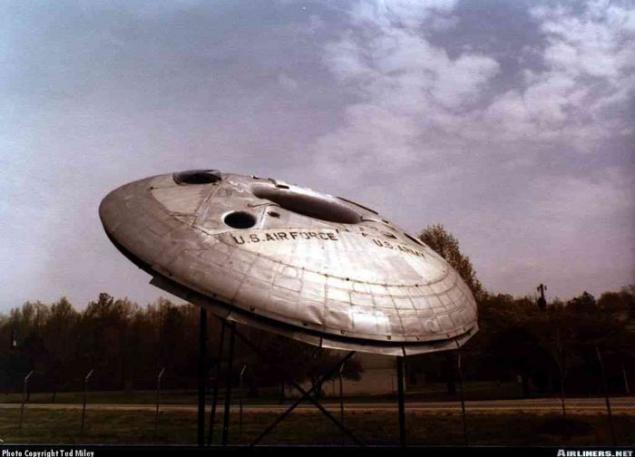

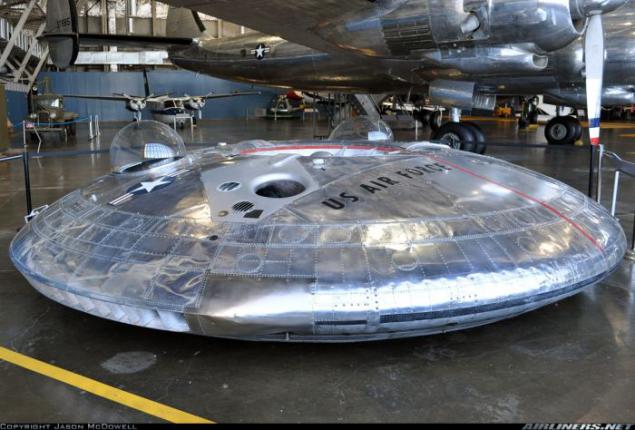

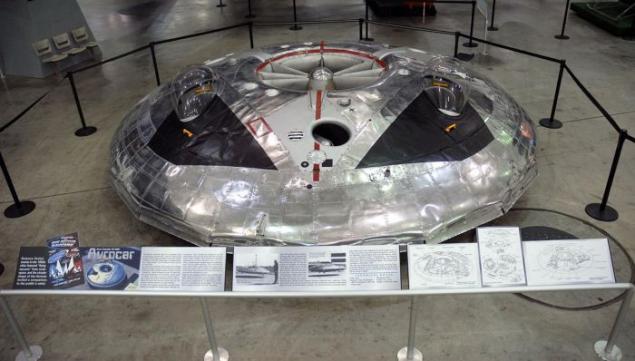

Also cast by the fan air flow mixed with the gas turbojet and used to form an air cushion will have a much lower speed and temperature than the turbojet engine, which should simplify the operation of the VTOL. Therefore, the development of VTOL firm "Avro Erkraft" interested in the Air Force and the US Army, who participated in the research funding should be noted that the scheme VTOL with a disk-shaped carrier body and located therein fan was offered ac. BN Yuriev even in 1921, the scheme, see "Russia. Research screw VTOL ».

In 1959, the contract for the combined Army and US Air Force has completed the construction of an experimental VTOL with a disk-shaped body which has received official designation VZ-9V, and the name "avrocar" and better known under the name "Flying Soser" (flying saucer). The first tests on a leash VTOL VZ-9V began to take place December 5, 1959, making a short flight, and soon was transferred to the Air Force base test them. Edwards. First off with the transition to horizontal flight took place May 17, 1961

Frost decided to use the already usual for that time reactive thrust in combination with the so-called Coanda effect. The essence of this phenomenon lies in the fact that the jet of liquid or gas, moving close to any object tends to get closer to her, or even the "stick." As planned Frost, this behavior was to facilitate the air handling unit. First, engineers Avro Canada made a small unit to demonstrate their ideas. The model with a diameter of 11 centimeters could rise into the air at low altitude, but there are no mechanisms for maneuvering it did not fit. Nevertheless, the Canadian Defense Ministry interested in the idea and has allocated about 400 thousand US dollars to continue the work. Shortly thereafter, the project has received index Y2.

At this stage, the future Avrocar became the object of espionage drama. Since 1952, the CIA was trying to find out whether some of the new aircraft designs. In the 53 th Scouts learned about the existence of the project Y2 and reported it to his superiors. Shortly after the transfer of documents "up" the gentlemen of the Pentagon contacted the Canadian military and asked them to continue creating Y2 together. Canada has adopted the proposal. Among other things, it was nice, and the financial implications. Head of research department USAF Lieutenant General J. Patt knocked the funding of two million dollars a year. Very boldly for a revolutionary new project. However, the money was allocated and Avro continued research. By mid-decade, the project was ready VZ-9, which is, strictly speaking, was the "swan song" of the program Y2.
Development VTOL VZ-9V led by John Frost and his tests were conducted in the greatest secrecy, so it was published on the very limited information. Perhaps the extraordinary form of VTOL and the lack of official data on the tests conducted in 1961 - 1962 years., Called this period of intense publication about flying unidentified flying objects (UFO) in the form of "flying saucers».

Of fifteen disk with six turbojet engines, which emit gases through its own nozzle and drives the rotation of the turbine large size could theoretically climb to any height and fly in any direction. The customer in the face of US and Canadian military approved the project, but asked at first to try the new technology at a manned machine smaller. Because of this "plate" uzhali to a diameter of about six meters. Appropriately modified and powerplant: Now around the center of the turbine was located only three engines. Interesting flight control system. To raise or lower draft was supposed to change all engines at once, which affects the momentum of the turbine lift. To tilt in one direction or another Avrocar had a special system that changed the thrust of individual engines so that housing unit due to its differences leaning in the right direction. With this system had pretty tricky: it was necessary to take into account the engine response, stability of the whole system and a host of other parameters.

In mid-1959 the first prototype "avrocar" was ready. It is time for the test. The first week went to the training of interaction engines and control systems. It was not easy, but Canadians and Americans to deal with it. By November of that year, VZ-9 unit was ready for the first flight. November 12 "flying saucer" off the ground and hovered at low altitude. Over time, we began to gain traction and output device for a little more height. At a distance of about one meter from the ground Avrocar hanging loosely, maneuvered and can move in any direction. But when it came to rise to a height of at least several meters, suddenly it became clear one very unpleasant feature of the project. Relatively weak power plant prototype could provide a satisfactory stability and control only to a height of one and a half meters. With a further rise "avrocar" had to rely solely on the Coanda effect. Screen effects, in turn, was lost and the aircraft lost its former stability. After a series of test flights engineers "Avro Canada" had to go back for Cullman. Meanwhile, the results of disgruntled Canadian military came to the conclusion about the futility of the project and refused to continue to give out money.

Over the next months, a team of designers under the George. Frost was trying to find a solution for the detected problems and provide adequate stability. At this stage of the work it has been collected a few models, which worked out new ideas. However, none of the models are not able to rise to a decent height and it does not turn over. Among the reasons for this behavior sets the number and the absence of additional air support (the same ground effect), and demanding designs to accurately and precisely balanced and the need to synchronize the engines.
Correct all this was possible only by means of a fundamental change in the structure. In late 1960, Frost began refining the project in accordance with the collected experiences. Starting from 1959, the year the project financing Y2 carried out only by the United States. Responsible for maintaining the program, US officials eventually became too doubt its feasibility. Therefore, soon after the start of a radical modernization of the funding "avrocar" stopped. Staff at the Pentagon have been tough and terse. The document on the termination of studies indicates the futility of the project, as well as the absence of any satisfactory result at a cost of about twelve million dollars.
In 1962, the development of VTOL VZ-9V was discontinued.

Recent tests carried out VTOL VZ-9V «avrocar" showed that it is not sufficiently resistant, in addition, constantly experience problems in its propulsion system and control system caused the termination of its test, despite the touted prospects for its use.

The principal difference between the experimental VTOL VZ-9V «avrocar" was that he could not only fly like an airplane at high altitude, but also to move close to the ground on an air cushion. The unit had a round disc-shaped body, the center of which was a fan. They sucked air through the system of channels directed to the single-loop ring nozzle that passes along the periphery of the device.

The lifting force when hovering or moving VTOL VZ-9V near the ground to create, first, thanks to the air cushion formed during the outflow of air from the annular nozzle, and secondly, as a result of so-called Coanda effect, which is usually manifested in the outflow of air from profiled nozzle above the surface to: create a vacuum gives rise to a lifting force. The VTOL VZ-9V when the flow of air through the ejection nozzle due to suction of air performed from the upper surface of the housing unit, causing underpressure therein and create additional lift.
The air ejected through the annular gap on the upper surface of the housing unit. Central fan diameter of 1, 52 m was driven by the low-speed turbine, driven in rotation by the flow of gas emanating from a nozzle three turbojet Continental J69-T9 with a thrust of 420 kg, or an equivalent power of 1,000 bhp To create a horizontal thrust ring air curtain can be deflected by a rotary control surfaces in an annular nozzle.

VTOL transition from movement on an air cushion above the ground to the coast as follows: VTOL accelerated above the ground on an air cushion to such a speed that its disc-shaped body creating a lifting force sufficient to maintain in the air, and then for his recovery. This annular jet, rolling, turning into flat veil and flowing out of the annular air nozzle creating horizontal thrust.

Built experimental VTOL VZ-9V «avrocar" designed to fly at subsonic speeds, so it had a rounded toe ring round the wing and the air intake on the perimeter of the wing to enter the ejected air flow. Round disc-shaped body with a diameter of 5 5 m was elliptical profile with a relative thickness of 20% and 2% of curvature. Features VTOL VZ-9V not been published, but indicated that he may have a maximum speed of 480 km / h.

Firm "Avro Erkarft" was designed as a supersonic VTOL variant of this type, whose wing was to have a sharp edge and a modified intake system ejected air. Such an apparatus different structural compactness and may have a relatively small mass; it is configured with a circular wing advertised as optimal for flying at low altitudes at high speeds, on the condition that will be solved the problem of stability.


To have survived both the built prototype Avrocar, which are stored in aviation museums in the US. Ten years ago, a number of Canadian historians made for the transfer of one of the "avrocar" in the hands of Canada. They explained this by the need of recognition of the country in the creation of the project. This theme fund shares somehow get round, although the US has spent on the program Y2 in more than ten times more money than their northern neighbor. In particular, and therefore the beginning of the two thousandth talk remained talk, and both built VZ-9 still are in American museums.









